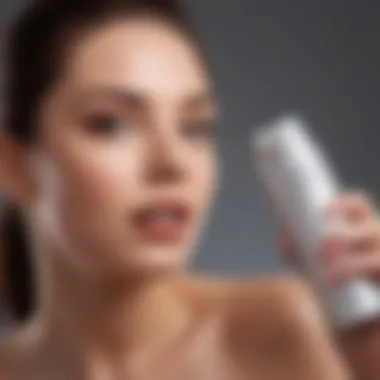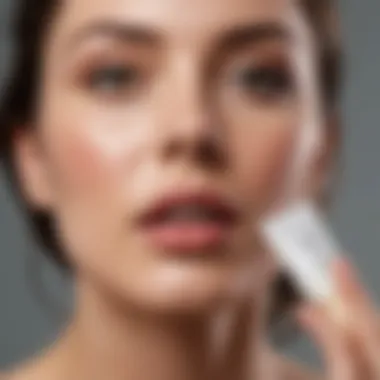Understanding Women's Pubic Hair Removal Cream: A Guide


Intro
The subject of women's pubic hair removal cream remains relevant in today's grooming culture. Many women seek various methods to manage their body hair, especially in sensitive areas. This guide aims to shed light on different aspects of these creams, from their types and benefits to potential risks and application techniques.
Why Discuss Pubic Hair Removal?
The conversation around personal grooming is dynamic. Women often choose to remove pubic hair for diverse reasons. These include aesthetic preferences, hygiene considerations, and ease of maintenance.
Moreover, cultural influences and societal expectations play a role in shaping these choices. Therefore, understanding the products available is vital for informed decision-making in personal grooming.
Types of Pubic Hair Removal Creams
There are several varieties of hair removal creams specifically designed for women's intimate areas. Some common types include:
- Depilatory Creams: These creams break down hair structure, allowing for easy removal. Brands like Nair and Veet offer formulations suitable for sensitive skin.
- Moisturizing Creams: Certain products combine hair removal with skin conditioning. This dual function helps reduce irritation.
- Natural Formulations: A growing number of women prefer products with organic ingredients, minimizing chemical exposure. Brands that focus on natural ingredients cater to this eco-conscious demographic.
Benefits of Using Hair Removal Creams
Using pubic hair removal creams comes with various advantages. First and foremost, these products provide a painless alternative to traditional methods like shaving or waxing. Additionally, creams are often quick and easy to apply, with results visible shortly after use.
Other benefits include:
- Less Risk of Cuts: Unlike shaving, creams do not involve sharp blades, significantly lowering the risk of nicks and cuts.
- Longer-Lasting Results: Some women find that hair removal creams yield results that last longer than shaving, though not as long as waxing.
Removing hair with a cream can enhance comfort in various styles and clothing.
Potential Risks Associated with Hair Removal Creams
While convenient, these creams are not devoid of risks. Skin irritation is one of the most common concerns, as the sensitive skin in the pubic area may react adversely to certain chemicals. It is crucial to conduct a patch test before full application.
Other potential issues include:
- Allergic Reactions: Some women may experience allergic reactions to ingredients. Always consult the ingredient list.
- Chemical Burns: Leaving the cream on for extended periods can lead to burns, as the chemicals are designed to break down hair but can also damage skin if misused.
Safe Application Techniques
To minimize risks, adhering to proper application guidelines is essential. Here are some tips for safe use:
- Read Instructions Carefully: Different brands may have variant formulations. Always follow the specific directions given.
- Perform a Patch Test: Apply a small amount of cream on a less sensitive area to check for adverse reactions.
- Avoid Sensitive Areas: Ensure the cream does not come into contact with mucous membranes.
- Moisturize Post-Application: After using hair removal creams, apply a gentle, fragrance-free moisturizer to soothe the skin.
Epilogue
Consideration of skin health, along with preferences, is fundamental in navigating the choices. As personal grooming continues to evolve, remaining educated about available products will enable women to make choices that align with their values and comfort.
Prologue to Pubic Hair Removal
The growing conversation surrounding women's pubic hair removal reflects a significant aspect of personal grooming and societal trends. This section aims to elucidate the relevance of pubic hair removal, acknowledging its implications on self-image, hygiene, and personal choice. As women navigate a plethora of methods available, understanding this topic becomes crucial for informed decision-making.
Pubic hair removal is not merely a cosmetic choice; it encompasses a range of factors that contribute to an individual's sense of comfort and identity. Recognition of these factors can lead to more empowering choices concerning body hair. Factors such as cultural norms, personal preferences, and the influence of media play considerable roles in shaping attitudes toward body hair.
Moreover, as more products enter the market catering specifically to hair removal, understanding their efficacy, safety, and impact on skin health becomes essential. This guide addresses various hair removal methods and equips readers with knowledge to navigate their choices wisely. In doing so, it emphasizes the importance of personal agency and informed decision-making in what is often a misunderstood aspect of grooming.
Types of Hair Removal Methods
The topic of hair removal methods is significant in the context of women's pubic hair removal creams. Understanding these various methods contributes to making informed choices about personal grooming. Each method presents unique benefits and drawbacks that may appeal to different individuals. Familiarity with both traditional and modern hair removal techniques can assist in selecting the most appropriate option based on personal preference, skin type, and hair characteristics. This comprehensive understanding contributes to a more empowered decision-making process.
Traditional Methods
Traditional methods of hair removal include techniques like plucking, threading, and using razors. Plucking involves removing hair follicle by follicle, which can be tedious but allows for precise hair removal. Threading, often used in some cultures, utilizes a thin thread to snatch hairs from the follicle. While these methods provide a clean appearance, they can be time-consuming and may cause discomfort.
One advantage of traditional methods is the immediate availability, as they often require no special products. In some cases, they may also offer better control for shaping hair in specific areas. However, the manual nature of these techniques can lead to skin irritation, especially in sensitive regions. Therefore, while traditional methods are viable options, they may not provide the speed or comfort sought by many.


Modern Methods
Modern hair removal methods have increasingly gained popularity due to their efficiency and ease of use. These methods include waxing, shaving, and the application of hair removal creams. Each has particular aspects that influence their suitability for various users.
Waxing
Waxing is a widely practiced hair removal technique that uses a sticky substance to pull hair from the root. This method is known for its longer-lasting results compared to shaving. The primary characteristic of waxing is its ability to remove multiple hairs simultaneously, making it an efficient choice for those seeking speed in their grooming routines.
Furthermore, waxing can lead to smoother skin for weeks at a time. The disadvantage lies in the pain associated with the procedure. Skin sensitivity can vary, and many individuals report discomfort during waxing. Additionally, chances of ingrown hairs may arise, which can lead to irritation. Nevertheless, waxing remains popular for its effectiveness and long-lasting results.
Shaving
Shaving is perhaps the most common hair removal method. It involves using a razor to cut hair at the skin's surface. One key characteristic of shaving is its simplicity and convenience, as it can be done quickly, often with minimal tools. For many, shaving is an accessible option that requires just a reliable razor and possibly some shaving cream or gel for better glide.
However, while shaving is rapid, it is important to note that results are short-lived. Hair tends to grow back quickly, often within a few days. This method can also lead to razor bumps and cuts if not done carefully. As such, while shaving is convenient, it may not fulfill the desire for a longer-term solution.
Creams
Hair removal creams represent a modern alternative, often appreciated for their convenience. These creams work by breaking down the protein structure of hair, allowing for easy removal. A distinct aspect of hair removal creams is that they can be applied quickly and require little effort in their use, making them appealing for busy lifestyles.
The benefits of using creams include a pain-free experience and a lower likelihood of cuts or skin irritation compared to shaving. Additionally, results can last a bit longer than shaving. On the downside, some individuals may experience skin reactions, especially if unaware of their skin's sensitivity to the cream's ingredients. Consequently, while creams can be effective and easy to use, it is critical to be mindful of potential skin allergies or reactions.
Understanding the variety of hair removal methods allows for informed decisions. Each method possesses unique characteristics that can better meet differing personal grooming needs.
Understanding Hair Removal Creams
Understanding women's pubic hair removal creams is essential for making informed decisions about personal grooming. The choice of hair removal methods can significantly impact skin health, comfort, and aesthetic preferences. This section aims to clarify the integral aspects of hair removal creams by examining their composition, how they function, and why they are a popular choice among women.
Composition and Ingredients
Hair removal creams, often referred to as depilatories, have a specific chemical composition designed to dissolve hair proteins. The key ingredients typically include calcium thioglycolate, potassium thioglycolate, and sometimes certain fragrances to mask the chemical scent.
Common components include:
- Calcium Thioglycolate: This is the primary active ingredient. It breaks down the protein structure of hair.
- Potassium Thioglycolate: Often found alongside calcium thioglycolate, enhancing the effectiveness.
- Emollients: Ingredients like lanolin or glycerin help to moisturize the skin, reducing chances of irritation.
- Fragrance and Preservatives: Added for aesthetic reasons, although these can be potential irritants for sensitive skin.
Before using a removal cream, checking the ingredient list is advisable, especially for those with sensitive skin or known allergies.
How Hair Removal Creams Work
The mechanism of action for hair removal creams is relatively straightforward but effective. When applied to the skin, the chemicals penetrate the hair shaft and break down the keratin structure. This process results in the hair becoming weak and ultimately easy to wipe away, usually within a few minutes.
Steps to using hair removal creams effectively:
- Apply: Evenly spread the cream to the desired area without rubbing it in.
- Wait: Allow the cream to sit for the recommended time, usually between 3-10 minutes.
- Wipe Off: Use a damp cloth or the tool provided with the product to remove the cream and hair.
- Rinse: Clean the area thoroughly with water to remove any residue left from the cream.
It is crucial to follow the manufacturer's instructions carefully. Leaving the cream on for too long can increase the risk of skin irritation or, in severe cases, chemical burns.
"Using hair removal creams can be effective, but understanding their ingredients and application is key to avoiding complications."
In summary, comprehending the components and mechanisms behind women's pubic hair removal creams empowers informed decisions in personal grooming routines. This section sets the groundwork for evaluating the potential benefits and risks involved in using these products.
Advantages of Using Hair Removal Creams
Hair removal creams offer a range of benefits that make them an appealing option for many women. Understanding these advantages can help users make informed decisions regarding their grooming methods.
Convenience and Speed
One of the primary benefits of using hair removal creams is their convenience. Unlike waxing or shaving, which require more time and preparation, creams can be applied in just a few minutes. This method allows for quick removal of hair during a busy day. Most creams are designed to dissolve hair at the skin's surface, leading to a smooth finish without extensive effort.
Using a cream can also be performed in the privacy of one's home. This eliminates the need for appointments at salons, providing users with the comfort of making a choice based on their own schedule.


Pain-Free Alternative
Another significant advantage is the pain-free nature of hair removal creams. Many women are put off by traditional hair removal methods that can involve discomfort, such as waxing. Creams do not tug on the skin or pull out hair from the roots, leading to a milder experience.
Pain sensitivity varies among individuals, but most users report significantly less discomfort when using creams compared to waxing or other more invasive techniques. For those who have sensitive skin or a low pain threshold, hair removal creams can offer a gentle alternative that does not compromise effectiveness.
"Choosing hair removal creams means trading discomfort for convenience, making it an option worth considering for many."
Potential Risks and Drawbacks
Understanding the potential risks and drawbacks of using women's pubic hair removal cream is crucial. Users should be informed about the negative effects these products may cause. While hair removal creams can be effective, they may result in various side effects. It is important to evaluate these risks, particularly concerning skin health.
Skin Reactions and Allergies
Skin reactions are one of the primary concerns with hair removal creams. Many of these products contain strong chemicals. These chemicals can irritate sensitive skin, leading to redness, itchiness, or swelling.
Some individuals may have pre-existing sensitivities or allergies to certain ingredients. Performing a patch test before full application can help identify potential reactions.
- If irritation occurs, discontinue use immediately.
- Seek medical help if reactions are severe or persistent.
Chemical Burns
Another significant risk associated with hair removal creams is the possibility of chemical burns. These burns happen when the product stays on the skin longer than recommended or when the skin is particularly sensitive.
Chemical burns can cause:
- Severe discomfort
- Blistering
- Skin peeling
To prevent such incidents, it is advised to follow the application instructions meticulously. Never underestimate the potency of these creams, as they are designed to break down hair at the follicle.
Ineffectiveness for Coarse Hair
While hair removal creams work well for many hair types, they may not be effective on coarse hair. Coarse hair is thicker and may require more aggressive methods for removal.
Users should comprehend that:
- Hair removal creams might not fully eliminate coarse hair.
- Results may vary, leading to partial hair removal and uneven surfaces.
Guidelines for Safe Use
Guidelines for safe use of pubic hair removal cream are essential for ensuring skin health and achieving desired results. Understanding these guidelines minimizes the risks associated with topical products. They serve not only to enhance effectiveness but also to protect sensitive areas from potential harm. Adhering to best practices can result in a more satisfactory grooming experience, turning a commonplace task into a routine defined by safety and confidence in results.
Performing a Patch Test
Performing a patch test is crucial when using any hair removal cream. This test informs you about how your skin will react to the product without risking extensive areas. To carry it out, apply a small amount of the cream on a discreet area of skin, like the inner elbow, and observe for any adverse reactions over the next 24 hours. This simple step helps in identifying potential allergies or sensitivities without compromising skin health.
It is worth noting that even products marketed as hypoallergenic can sometimes cause reactions. Therefore, the patch test is not just a recommendation; it is a necessary precaution.
Proper Application Techniques
Proper application techniques can significantly influence the effectiveness of hair removal creams. First, ensure that the area is clean and dry. This allows the cream to penetrate more effectively. Use the applicator provided with the cream or a spatula to apply an even layer, avoiding any excessive accumulation. The goal is to cover the hair, not to produce a thick layer of product.
Timing is also vital. Adhere strictly to the instructions provided on the packaging regarding how long to leave the cream on the skin. Leaving it on for too long can provoke skin irritation and undermine the product's effectiveness. After the required time, remove the cream gently as instructed, usually with a damp cloth or the spatula. Rinse the area thoroughly with cool water to stop any residual chemical reactions.
Recommended Products
Choosing the right hair removal cream is fundamental to a safe and effective process. Some brands are specifically formulated for sensitive skin, containing soothing agents to mitigate irritation. When searching for suitable options, look for products with ingredients like aloe vera and chamomile, which can help calm the skin.
Here is a short list of brands known for their effective formulations:
- Nair: Offers a range of cream options designed for various skin sensitivities.
- Veet: Known for its quick-acting formulas with added moisturizing properties.
- Sally Hansen: Provides specific products for delicate areas, ensuring gentler application.


Always read product reviews and verify that the ingredients align with your skin needs. Checking recommendations from trusted sources, such as dermatologists or beauty experts on platforms like reddit.com, can also offer insights into the most suitable options for your individual requirements.
"Understanding safe use guidelines is key to avoiding complications and ensuring a smooth hair removal experience."
Following proper guidelines can optimize your hair removal routine, making it effective and worry-free.
Post-Application Care
Post-application care is a vital aspect of using women's pubic hair removal creams. After the cream has been applied and removed, the skin can be sensitive and may require additional attention to avoid irritation and maintain skin health. Taking the right steps during this phase can enhance the overall experience, minimize any potential discomfort, and ensure that the skin remains smooth and healthy.
Cleansing the Area
It is essential to cleanse the area thoroughly after using hair removal cream. This step serves two main purposes. First, it removes any residue left by the cream that could cause irritation. Second, cleansing helps prevent infections by ensuring that the area is free from bacteria. When cleansing, use a mild soap and lukewarm water. Avoid using harsh products or scrubbing the skin roughly, as this can exacerbate sensitivity. Gently pat the area dry with a clean towel to avoid irritation from friction. A smart move is to use unscented products, which help to minimize any potential allergic reactions.
Moisturizing Techniques
Once the area is clean, it’s important to use a suitable moisturizer. Moisturizing helps restore hydration to the skin, which may have been stripped away during the hair removal process. The right moisturizer can soothe irritation and reduce the likelihood of redness. Look for products containing natural ingredients like aloe vera or vitamin E, both known for their calming properties. Apply a small amount and gently massage it into the skin. Avoid products with fragrances or alcohol, as these can lead to further irritation.
Signs of Complications
Being vigilant about post-application care means being aware of any signs of complications. While many users experience no issues, some may encounter adverse effects. Common signs of complications include redness, swelling, blistering, or persistent itching. If any of these symptoms occur, it is crucial to cease using the product and consult a healthcare professional if necessary. Moreover, document any reactions to discuss with a dermatologist, as this can guide future choices in hair removal products. It’s better to err on the side of caution when it comes to skin health.
"Post-application care is as important as the application itself. A good routine can prevent complications and improve skin condition."
In summary, taking care of the skin post-application is critical for a good experience with pubic hair removal creams. By cleansing properly, moisturizing with the right products, and being aware of any complications, individuals can enjoy smoother, healthier skin.
User Experiences and Opinions
Understanding the user experiences surrounding pubic hair removal creams brings valuable insight into the practical realities of using these products. Women's opinions are shaped by personal stories, trial and error, and the varying levels of satisfaction achieved. Collecting this feedback can illuminate patterns and highlight both benefits and concerns.
Incorporating user experiences into this article is essential for several reasons. First, it provides a real-world perspective that goes beyond product descriptions and marketing messages. Women want to know what they can expect when trying these creams. This includes ease of use, effectiveness, and potential side effects. Additionally, these experiences often reveal preferences for certain brands or formulations, aiding others in making educated choices.
By presenting a balanced view of user opinions, this guide also addresses common fears and uncertainties. For instance, many users report anxiety related to skin reactions. Understanding that others have had similar worries can be reassuring.
Surveys and Feedback
Surveys serve as an effective tool for gathering a wide range of user feedback regarding pubic hair removal creams. They provide quantitative data on customer satisfaction, allowing for analysis of trends and common pain points. Key aspects often covered in these surveys include:
- Ease of application: Reviewers frequently mention how simple the cream is to use.
- Effectiveness: Many respondents rate the cream based on how well it removes hair.
- Skin sensitivity: Insight into reactions, ranging from mild irritation to allergic responses, is crucial in understanding product safety.
- Scent and texture: These subjective attributes often influence user preference.
Online platforms, such as Reddit or Facebook, often share links to survey results. Women reading this article can glean from their peers, which is often more trustworthy than advertising claims.
Case Studies
Case studies present a deeper narrative about individual experiences with pubic hair removal creams. They can illustrate the outcomes clearly and enable readers to relate to specific situations. In a case study format, aspects such as user demographics, specific products used, and the outcomes are outlined. This can be structured in a straightforward fashion:
- User Demographics: Age, hair type, and skin type provide insight into varied results.
- Product Information: The specific cream name, along with related ingredients.
- Application Process: Step-by-step recounting of how the cream was used, including any alterations made during the process.
- Results and Duration: Detailed effects on hair removal, skin condition post-use, and how long the results lasted.
These narratives can help build a more nuanced understanding of how each product might work for different users. Information from platforms like Wikipedia and Britannica underscores the importance of context in such discussions, highlighting that not every product behaves identically across diverse skin types and conditions.
"Individual experiences can reshape product expectations and motivate others to try or avoid certain creams."
By illustrating a diverse range of responses through surveys and case studies, this article empowers women to make informed decisions tailored to their unique circumstances.
Finale
The topic of hair removal, particularly through the use of creams, is essential due to its impact on personal grooming choices. In this article, we reviewed various aspects of women's pubic hair removal creams, exploring not just how they work but also their advantages and risks. Understanding these elements allows women to make informed decisions about their grooming routines. The choice of method can influence comfort, skin health, and overall satisfaction with personal grooming.
Final Thoughts on Hair Removal Choices
Choosing a hair removal method is deeply personal and varies from one individual to another. Factors like skin sensitivity, hair type, and lifestyle preferences all play a role in this decision-making process. While creams offer convenience and quick results, they are not the only option. Alternatives like waxing or shaving can be more suitable depending on individual circumstances. It's clear that evaluating these choices is critical. Taking the time to assess what works best for your body can lead to a more positive and confident experience.
Encouragement for Informed Decisions
It is vital for women to educate themselves regarding the products they use, especially for sensitive areas. Reading reviews, understanding the composition of ingredients, and conducting patch tests are essential steps for ensuring safety. By gathering information from various sources, including online communities on platforms like Reddit, women can share experiences and learn from one another. Ultimately, informed decisions lead to better outcomes in personal grooming. Remember, the goal is to find what makes you feel comfortable and confident, prioritizing health along the way.
Knowledge and preparation can significantly enhance your personal grooming journey.
In summary, the path to choosing the right hair removal method is filled with options. What matters most is choosing a method that aligns with individual needs and promotes skin health.



